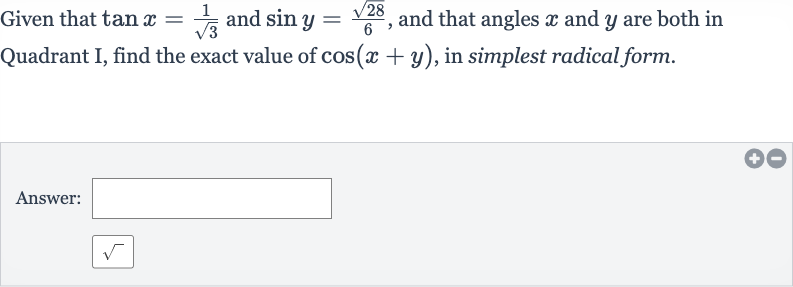Full solution
Q. Given that and , and that angles and are both in Quadrant I, find the exact value of , in simplest radical form.Answer:
- Find : We know that . Since is in Quadrant I, both sine and cosine are positive. We can find using the Pythagorean identity , and the fact that .
- Express : First, let's express in terms of . We have , so . We know , so .
- Use Pythagorean identity: Now, we use the Pythagorean identity . Substituting with , we get .
- Solve for : Simplifying the equation, we have . Combining like terms, we get , which simplifies to .
- Find : To find , we solve for by multiplying both sides by , which gives us . Taking the square root of both sides, we get , since is in Quadrant I and cosine is positive.
- Substitute : Next, we need to find . We are given . Using the Pythagorean identity , we can find .
- Simplify the equation: Substitute with into the identity: . Simplifying, we get .
- Find : Subtracting from both sides, we get . Simplifying further, we get .
- Use cosine sum formula: Taking the square root of both sides to find , we get . Since is in Quadrant I, is positive, so .
- Find : Now we have both and . We can use the cosine sum formula to find : .
- Substitute all values: We already have and . We need to find , which we can get from and . Since , we have .
- Simplify the expression: We already have . Now we can substitute all values into the cosine sum formula: .
- Combine the terms: Simplifying the expression, we get .
- Simplify the numerator: To combine the terms, we need a common denominator. Multiplying the first term by , we get - = .
- Final simplification: Simplifying the numerator, we get .
- Final simplification: Simplifying the numerator, we get .Finally, we can simplify the expression by dividing both numerator and denominator by , which gives us as the exact value of in simplest radical form.

